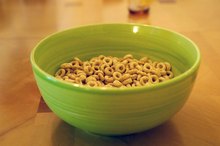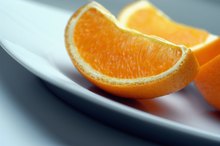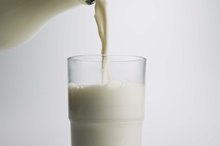Niacin & Anxiety
Emotional and physical stress often leads to feelings of anxiety. Anxiety is a normal reaction to stress in moderation. However, for some people, anxiety becomes excessive, difficult to control and negatively impacts day-to-day living. Anxiety disorders include post-traumatic stress disorder, obsessive-compulsive disorder and specific phobias to name a few. Niacin has a long history of treating the symptoms of anxiety and depression, although it is not a cure for either condition. Consult a health professional before taking niacin for any reason.
Anxiety Symptoms and Incidence
Anxiety has many emotional and physical triggers, although it is usually characterized by a collection of symptoms, including nervousness, gastrointestinal pain, increased heart rate, high blood pressure and insomnia, as noted in “Professional Guide to Diseases." Anxiety disorders can lead to panic attacks, which can trigger heart attacks in rare instances. According to the National Institute of Mental Health, over 18 percent of the U.S. adult population is diagnosed with an anxiety disorder that lasts at least one year. A significant cause of anxiety is chronic over-stimulation of the sympathetic nervous system, which triggers the "fight-or-flight" response and floods the body with hormones and chemicals, such as adrenaline.
- Anxiety has many emotional and physical triggers, although it is usually characterized by a collection of symptoms, including nervousness, gastrointestinal pain, increased heart rate, high blood pressure and insomnia, as noted in “Professional Guide to Diseases."
Functions and Properties of Niacin
Does Niacin Help With Weight Loss?
Learn More
Niacin, also called vitamin B3, is needed for DNA repair, synthesis of steroidal hormones and energy metabolism within the body. A strong property of niacin is its ability to relax the muscle tissue composing arteries, which increases their diameter. This process, called vasodilation, leads to increased blood flow and reduced blood pressure. According to “Biochemistry of Human Nutrition,” niacin also raises blood levels of HDL, the "good" cholesterol, and reduces levels of LDL, the “bad” cholesterol, which further improves cardiovascular health. Perhaps most important with respect to anxiety, niacin is an antidote to adrenaline, which is often over-produced in those experiencing anxiety.
- Niacin, also called vitamin B3, is needed for DNA repair, synthesis of steroidal hormones and energy metabolism within the body.
- According to “Biochemistry of Human Nutrition,” niacin also raises blood levels of HDL, the "good" cholesterol, and reduces levels of LDL, the “bad” cholesterol, which further improves cardiovascular health.
Niacin and Anxiety
Anecdotally, it is claimed by some that niacin reduces anxiety and depression, while promoting calmness and better sleep. According to “Biochemical, Physiological and Molecular Aspects of Human Nutrition,” it is possible that niacin’s ability to increase blood flow, reduce blood pressure, eliminate excess adrenaline and regulate hormones could contribute to feelings of relaxation in those who are stressed. However, niacin is not considered a valid treatment for anxiety or depression by the U.S. Food and Drug Administration or the American Medical Association. Further, higher doses of niacin often lead to “flushing,” an uncomfortable redness, itchiness and mild burning that's due to widespread vasodilation of blood vessels beneath the skin. Ironically, niacin flushing might actually increase anxiety in those who take too much.
- Anecdotally, it is claimed by some that niacin reduces anxiety and depression, while promoting calmness and better sleep.
Niacin Dosages
What Are the Benefits of Lexapro?
Learn More
According to “Vitamins: Fundamental Aspects in Nutrition and Health,” the recommended daily allowance for niacin ranges from 2 mg in infants under 6 months old, to 17 mg for lactating women. Taking niacin in dosages of 100 mg or more can lead to flushing symptoms. Niacin flushing is usually felt more prominently in the face and upper neck. To avoid niacin flushing, some users prefer niacinamide, a synthetic form of niacin that doesn’t have vasodilating properties.
- According to “Vitamins: Fundamental Aspects in Nutrition and Health,” the recommended daily allowance for niacin ranges from 2 mg in infants under 6 months old, to 17 mg for lactating women.
- To avoid niacin flushing, some users prefer niacinamide, a synthetic form of niacin that doesn’t have vasodilating properties.
Related Articles
References
- “Professional Guide to Diseases: Ninth Edition”; Springhouse Publishing; 2009
- “Biochemistry of Human Nutrition”; George Gropper; 2000
- “Biochemical, Physiological and Molecular Aspects of Human Nutrition”; Martha Stipanuk; 2006
- “Vitamins: Fundamental Aspects in Nutrition and Health”; G. Combs; 2008
- National Institutes of Medicine Office of Dietary Supplements. Niacin Fact Sheet for Health Professionals. Updated June 3, 2020.
- MedlinePlus. Niacin. Updated June 4, 2020.
- Boden WE, Probstfield JL, Anderson T, et al. Niacin in Patients with Low HDL Cholesterol Levels Receiving Intensive Statin Therapy. N Engl J Med. 2011;365(24):2255-2267. doi:10.1056/NEJMoa1107579
- Morris MC, Evans DA, Bienias JL, et al. Dietary niacin and the risk of incident Alzheimer's disease and of cognitive decline. J Neurol Neurosurg Psychiatry. 2004;75(8):1093-1099. doi:10.1136/jnnp.2003.025858
- Elam MB, Hunninghake DB, Davis KB, et al. Effect of Niacin on Lipid and Lipoprotein Levels and Glycemic Control in Patients With Diabetes and Peripheral Arterial Disease: The ADMIT Study: A Randomized Trial. JAMA. 2000;284(10):1263-1270. doi:10.1001/jama.284.10.1263
- Zhai G. Alteration of Metabolic Pathways in Osteoarthritis. Metabolites. 2019;9(1):11. doi:10.3390/metabo9010011
Writer Bio
Owen Bond began writing professionally in 1997. Bond wrote and published a monthly nutritional newsletter for six years while working in Brisbane, Australia as an accredited nutritionalist. Some of his articles were published in the "Brisbane Courier-Mail" newspaper. He received a Master of Science in nutrition from the University of Saskatchewan.









